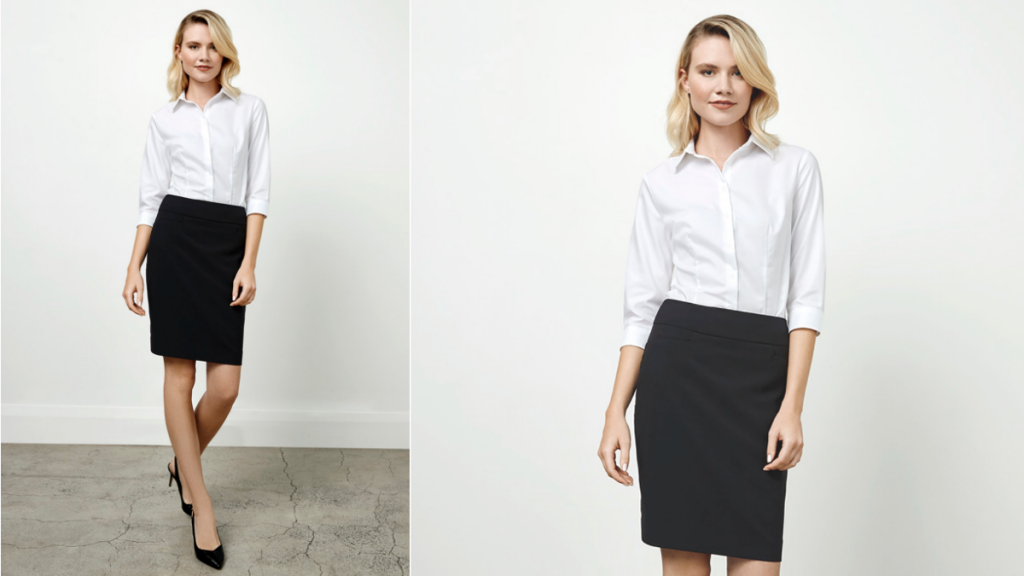When working in an office environment, it’s very important that you look smart and professional, but what does this mean? Basically, view the clothing you wear to work as a reflection of the company. Use your work clothing to convey professionalism and that you belong in the work environment.
Also, most businesses have a dress code. This could be a uniform or a certain type of acceptable outfit. Some places may allow you to dress in jeans and a golf shirt, while others insist on items like business casual pants and a well-fitting blouse.
So, what should you pick?
In today’s article, we are going to explore how to dress for success. We will also define terms found in the dress code.
Why is Knowing the Dress Code Important?
Each organisation has a different expectation of what staff should wear. Dress codes are especially important in businesses that deal directly with the public. And you should research the company’s policy even before you work for your new employer. Knowing the dress code before the interview is helpful as it will ensure you make a great impression and prove that you’re a good fit for the company.
Some companies may not outline a specific dress code. They could give you a definition, and you’re responsible for understanding what that means. Let’s look at some of the most common dress code definitions.
How to Ask About the Dress Code
If you’re unsure of the dress code, there are ways to find out what you’re expected to wear. You could:
- Ask your point of contact: This could be the hiring manager, recruiter or receptionist. Simply ask them about the dress code ahead of your interview.
- Network with employees: If you don’t want to ask the hiring manager, ask the other employees. You should be able to determine the dress code after your first day. Wear a suit or smart clothing for the interview because it’s better to overdress than under dress in these circumstances.
- Examine what others in a similar position are wearing: Visit the company social media accounts to determine what is acceptable office attire. Look for employees in a similar position and take inspiration from how they are dressed.
Dress Codes Defined
Business Professional Defined
If your dress code states that you should dress in a business professional manner, this means the office is very conservative. Businesses that are in the public eye, such as law, finance, banking, and the government usually all fall under this category.
A pants-suit, button-down shirt or knee-length pencil skirt and blazer would be perfect attire for this environment. If you plan on wearing high-heels stick to closed-toe shoes and the heel height shouldn’t be more than three inches. A nice pair of flats or loafers are also acceptable footwear.
Business Formal Defined
This dress code is usually reserved for special events. Women are expected to wear formal dresses, while men are required to wear a suit, jacket and tie. Events such as awards ceremonies, gala dinners and end of the year functions often fall into this category.
A good rule of thumb is to imagine you’re dressing for a red carpet. Again, it’s always better to be over dressed than underdressed.
Business Casual Defined
Don’t be fooled by the word casual. This dress code doesn’t mean you can show up to work and look like you’re going to the beach. You won’t be required to wear a suit and tie, but you will still need to look professional. If you aren’t sure what to wear, a good option is always a collared shirt with slacks, chinos, or a pencil skirt.
Bring a blazer too in case you need to attend a meeting. Adding a blazer to any outfit will make it look more professional. Shoes should always be closed toe, whether you choose boots, heels or flats.
Casual Workwear Defined
If your company has a casual dress code, you’re less restricted than other companies. Some offices have casual Fridays. This allows employees to wear jeans or other casual clothing on Fridays. This type of dress code is usually found in creative industries.
Avoid flip-flops and jeans that have rips and holes in them. Ensure you look neat and professional by wearing well-fitting clothing that isn’t too distracting.
Tips for Dressing for Your First Day of Work
Dressing for the first day of work may seem like a daunting task, but let’s help make choosing your outfit easier with these tips:
- Dress comfortably: Wear an outfit that looks smart but is still comfortable. You may feel a bit nervous on your first day, so wearing something comfortable may help you settle into your role more easily. Your outfit shouldn’t distract you from the job at hand.
- Wear layers: This will give you more options. Some offices have poor airflow so you may feel hot once inside. Others may use air conditioning which can cause you to get cold. Wearing layers and taking one off or adding a jacket when necessary allows you to be comfortable no matter what the environment is.
Final Thoughts
After reading this article, you should have a better idea of what acceptable work attire is and understand the most common types of definitions found in the dress code.
Does your company wear a uniform? Or have an even more casual approach to dressing? Let us know your styling tips for others in the comments below.




